Capital Budgeting Decisions Chapter Fourteen Mc GrawHillIrwin Copyright

Capital Budgeting Decisions Chapter Fourteen Mc. Graw-Hill/Irwin Copyright © 2008, The Mc. Graw-Hill Companies, Inc.

Typical Capital Budgeting Decisions Plant expansion Equipment selection Lease or buy Mc. Graw-Hill/Irwin Equipment replacement Cost reduction Copyright © 2008, The Mc. Graw-Hill Companies, Inc.

Typical Capital Budgeting Decisions Capital budgeting tends to fall into two broad categories. . . Screening decisions. Does a proposed project meet some preset standard of acceptance? Preference decisions. Selecting from among several competing courses of action. Mc. Graw-Hill/Irwin Copyright © 2008, The Mc. Graw-Hill Companies, Inc.

Time Value of Money A dollar today is worth more than a dollar a year from now. Therefore, investments that promise earlier returns are preferable to those that promise later returns. Mc. Graw-Hill/Irwin Copyright © 2008, The Mc. Graw-Hill Companies, Inc.

Time Value of Money The capital budgeting techniques that best recognize the time value of money are those that involve discounted cash flows. Mc. Graw-Hill/Irwin Copyright © 2008, The Mc. Graw-Hill Companies, Inc.

Learning Objective 1 Evaluate the acceptability of an investment project using the net present value method. Mc. Graw-Hill/Irwin Copyright © 2008, The Mc. Graw-Hill Companies, Inc.

The Net Present Value Method To determine net present value we. . . Calculate the present value of cash inflows, Calculate the present value of cash outflows, Subtract the present value of the outflows from the present value of the inflows. Mc. Graw-Hill/Irwin Copyright © 2008, The Mc. Graw-Hill Companies, Inc.

The Net Present Value Method General decision rule. . . Mc. Graw-Hill/Irwin Copyright © 2008, The Mc. Graw-Hill Companies, Inc.

The Net Present Value Method Net present value analysis emphasizes cash flows and not accounting net income. The reason is that accounting net income is based on accruals that ignore the timing of cash flows into and out of an organization. Mc. Graw-Hill/Irwin Copyright © 2008, The Mc. Graw-Hill Companies, Inc.

Typical Cash Outflows Repairs and maintenance Working capital Initial investment Incremental operating costs Mc. Graw-Hill/Irwin Copyright © 2008, The Mc. Graw-Hill Companies, Inc.

Typical Cash Inflows Salvage value Release of working capital Reduction of costs Incremental revenues Mc. Graw-Hill/Irwin Copyright © 2008, The Mc. Graw-Hill Companies, Inc.

Recovery of the Original Investment Depreciation is not deducted in computing the present value of a project because. . . It is not a current cash outflow. Discounted cash flow methods automatically provide for return of the original investment. Mc. Graw-Hill/Irwin Copyright © 2008, The Mc. Graw-Hill Companies, Inc.

Recovery of the Original Investment Carver Hospital is considering the purchase of an attachment for its X-ray machine. No investments are to be made unless they have an annual return of at least 10%. Will we be allowed to invest in the attachment? Mc. Graw-Hill/Irwin Copyright © 2008, The Mc. Graw-Hill Companies, Inc.

Recovery of the Original Investment Present value of an annuity of $1 table Mc. Graw-Hill/Irwin Copyright © 2008, The Mc. Graw-Hill Companies, Inc.

Recovery of the Original Investment This implies that the cash inflows are sufficient to recover the $3, 170 initial investment (therefore depreciation is unnecessary) and to provide exactly a 10% return on the investment. Mc. Graw-Hill/Irwin Copyright © 2008, The Mc. Graw-Hill Companies, Inc.

Two Simplifying Assumptions Two simplifying assumptions are usually made in net present value analysis: All cash flows other than the initial investment occur at the end of periods. Mc. Graw-Hill/Irwin All cash flows generated by an investment project are immediately reinvested at a rate of return equal to the discount rate. Copyright © 2008, The Mc. Graw-Hill Companies, Inc.

Choosing a Discount Rate • The firm’s cost of capital is usually regarded as the minimum required rate of return. • The cost of capital is the average rate of return the company must pay to its long-term creditors and stockholders for the use of their funds. Mc. Graw-Hill/Irwin Copyright © 2008, The Mc. Graw-Hill Companies, Inc.

The Net Present Value Method Lester Company has been offered a five year contract to provide component parts for a large manufacturer. Mc. Graw-Hill/Irwin Copyright © 2008, The Mc. Graw-Hill Companies, Inc.

The Net Present Value Method • At the end of five years the working capital will be released and may be used elsewhere by Lester. • Lester Company uses a discount rate of 10%. Should the contract be accepted? Mc. Graw-Hill/Irwin Copyright © 2008, The Mc. Graw-Hill Companies, Inc.

The Net Present Value Method Annual net cash inflow from operations Mc. Graw-Hill/Irwin Copyright © 2008, The Mc. Graw-Hill Companies, Inc.

The Net Present Value Method Mc. Graw-Hill/Irwin Copyright © 2008, The Mc. Graw-Hill Companies, Inc.

The Net Present Value Method Present value of an annuity of $1 factor for 5 years at 10%. Mc. Graw-Hill/Irwin Copyright © 2008, The Mc. Graw-Hill Companies, Inc.

The Net Present Value Method Present value of $1 factor for 3 years at 10%. Mc. Graw-Hill/Irwin Copyright © 2008, The Mc. Graw-Hill Companies, Inc.

The Net Present Value Method Present value of $1 factor for 5 years at 10%. Mc. Graw-Hill/Irwin Copyright © 2008, The Mc. Graw-Hill Companies, Inc.

The Net Present Value Method Accept the contract because the project has a positive net present value. Mc. Graw-Hill/Irwin Copyright © 2008, The Mc. Graw-Hill Companies, Inc.

Quick Check Denny Associates has been offered a four-year contract to supply the computing requirements for a local bank. • The working capital would be released at the end of the contract. • Denny Associates requires a 14% return. Mc. Graw-Hill/Irwin Copyright © 2008, The Mc. Graw-Hill Companies, Inc.

Quick Check What is the net present value of the contract with the local bank? a. $150, 000 b. $ 28, 230 c. $ 92, 340 d. $132, 916 Mc. Graw-Hill/Irwin Copyright © 2008, The Mc. Graw-Hill Companies, Inc.

Quick Check What is the net present value of the contract with the local bank? a. $150, 000 b. $ 28, 230 c. $ 92, 340 d. $132, 916 Mc. Graw-Hill/Irwin Copyright © 2008, The Mc. Graw-Hill Companies, Inc.

Learning Objective 2 Evaluate the acceptability of an investment project using the internal rate of return method. Mc. Graw-Hill/Irwin Copyright © 2008, The Mc. Graw-Hill Companies, Inc.

Internal Rate of Return Method • The internal rate of return is the rate of return promised by an investment project over its useful life. It is computed by finding the discount rate that will cause the net present value of a project to be zero. • It works very well if a project’s cash flows are identical every year. If the annual cash flows are not identical, a trial and error process must be used to find the internal rate of return. Mc. Graw-Hill/Irwin Copyright © 2008, The Mc. Graw-Hill Companies, Inc.

Internal Rate of Return Method General decision rule. . . When using the internal rate of return, the cost of capital acts as a hurdle rate that a project must clear for acceptance. Mc. Graw-Hill/Irwin Copyright © 2008, The Mc. Graw-Hill Companies, Inc.

Internal Rate of Return Method • Decker Company can purchase a new machine at a cost of $104, 320 that will save $20, 000 per year in cash operating costs. • The machine has a 10 -year life. Mc. Graw-Hill/Irwin Copyright © 2008, The Mc. Graw-Hill Companies, Inc.

Internal Rate of Return Method Future cash flows are the same every year in this example, so we can calculate the internal rate of return as follows: PV factor for the = internal rate of return $104, 320 $20, 000 Mc. Graw-Hill/Irwin Investment required Net annual cash flows = 5. 216 Copyright © 2008, The Mc. Graw-Hill Companies, Inc.

Internal Rate of Return Method Using the present value of an annuity of $1 table. . . Find the 10 -period row, move across until you find the factor 5. 216. Look at the top of the column and you find a rate of 14% Mc. Graw-Hill/Irwin Copyright © 2008, The Mc. Graw-Hill Companies, Inc.

Internal Rate of Return Method • Decker Company can purchase a new machine at a cost of $104, 320 that will save $20, 000 per year in cash operating costs. • The machine has a 10 -year life. The internal rate of return on this project is 14%. If the internal rate of return is equal to or greater than the company’s required rate of return, the project is acceptable. Mc. Graw-Hill/Irwin Copyright © 2008, The Mc. Graw-Hill Companies, Inc.

Quick Check The expected annual net cash inflow from a project is $22, 000 over the next 5 years. The required investment now in the project is $79, 310. What is the internal rate of return on the project? a. 10% b. 12% c. 14% d. Cannot be determined Mc. Graw-Hill/Irwin Copyright © 2008, The Mc. Graw-Hill Companies, Inc.

Quick Check The expected annual net cash inflow from a project is $22, 000 over the next 5 years. The required investment now in the project is $79, 310. What is the internal rate of return on the project? a. 10% $79, 310/$22, 000 = 3. 605, which is the present value factor b. 12% for an annuity over five years c. 14% when the interest rate is 12%. d. Cannot be determined Mc. Graw-Hill/Irwin Copyright © 2008, The Mc. Graw-Hill Companies, Inc.

Net Present Value vs. Internal Rate of Return v NPV is easier to use. v Questionable assumption: v. Internal rate of return method assumes cash inflows are reinvested at the internal rate of return. Mc. Graw-Hill/Irwin Copyright © 2008, The Mc. Graw-Hill Companies, Inc.

Net Present Value vs. Internal Rate of Return v NPV is easier to use. v Questionable assumption: v. Internal rate of return method assumes cash inflows are reinvested at the internal rate of return. Mc. Graw-Hill/Irwin Copyright © 2008, The Mc. Graw-Hill Companies, Inc.

Expanding the Net Present Value Method To compare competing investment projects we can use the following net present value approaches: w Total-cost w Incremental cost Mc. Graw-Hill/Irwin Copyright © 2008, The Mc. Graw-Hill Companies, Inc.

The Total-Cost Approach § White Company has two alternatives: (1) remodel an old car wash or, (2) remove it and install a new one. § The company uses a discount rate of 10%. Mc. Graw-Hill/Irwin Copyright © 2008, The Mc. Graw-Hill Companies, Inc.

The Total-Cost Approach If White installs a new washer. . . Let’s look at the present value of this alternative. Mc. Graw-Hill/Irwin Copyright © 2008, The Mc. Graw-Hill Companies, Inc.

The Total-Cost Approach If we install the new washer, the investment will yield a positive net present value of $83, 202. Mc. Graw-Hill/Irwin Copyright © 2008, The Mc. Graw-Hill Companies, Inc.

The Total-Cost Approach If White remodels the existing washer. . . Let’s look at the present value of this second alternative. Mc. Graw-Hill/Irwin Copyright © 2008, The Mc. Graw-Hill Companies, Inc.

The Total-Cost Approach If we remodel the existing washer, we will produce a positive net present value of $56, 405. Mc. Graw-Hill/Irwin Copyright © 2008, The Mc. Graw-Hill Companies, Inc.

The Total-Cost Approach Both projects yield a positive net present value. However, investing in the new washer will produce a higher net present value than remodeling the old washer. Mc. Graw-Hill/Irwin Copyright © 2008, The Mc. Graw-Hill Companies, Inc.

The Incremental-Cost Approach Under the incremental-cost approach, only those cash flows that differ between the two alternatives are considered. Let’s look at an analysis of the White Company decision using the incremental-cost approach. Mc. Graw-Hill/Irwin Copyright © 2008, The Mc. Graw-Hill Companies, Inc.

The Incremental-Cost Approach We get the same answer under either the total-cost or incremental-cost approach. Mc. Graw-Hill/Irwin Copyright © 2008, The Mc. Graw-Hill Companies, Inc.

Quick Check Consider the following alternative projects. Each project would last for five years. Project A Project B Initial investment $80, 000 $60, 000 Annual net cash inflows 20, 000 16, 000 Salvage value 10, 000 8, 000 The company uses a discount rate of 14% to evaluate projects. Which of the following statements is true? a. NPV of Project A > NPV of Project B by $5, 230 b. NPV of Project B > NPV of Project A by $5, 230 c. NPV of Project A > NPV of Project B by $2, 000 d. NPV of Project B > NPV of Project A by $2, 000 Mc. Graw-Hill/Irwin Copyright © 2008, The Mc. Graw-Hill Companies, Inc.

Quick Check Consider the following alternative projects. Each project would last for five years. Project A Project B Initial investment $80, 000 $60, 000 Annual net cash inflows 20, 000 16, 000 Salvage value 10, 000 8, 000 The company uses a discount rate of 14% to evaluate projects. Which of the following statements is true? a. NPV of Project A > NPV of Project B by $5, 230 b. NPV of Project B > NPV of Project A by $5, 230 c. NPV of Project A > NPV of Project B by $2, 000 d. NPV of Project B > NPV of Project A by $2, 000 Mc. Graw-Hill/Irwin Copyright © 2008, The Mc. Graw-Hill Companies, Inc.

Least Cost Decisions In decisions where revenues are not directly involved, managers should choose the alternative that has the least total cost from a present value perspective. Let’s look at the Home Furniture Company. Mc. Graw-Hill/Irwin Copyright © 2008, The Mc. Graw-Hill Companies, Inc.

Least Cost Decisions v. Home Furniture Company is trying to decide whether to overhaul an old delivery truck now or purchase a new one. v. The company uses a discount rate of 10%. Mc. Graw-Hill/Irwin Copyright © 2008, The Mc. Graw-Hill Companies, Inc.

Least Cost Decisions Here is information about the trucks. . . Mc. Graw-Hill/Irwin Copyright © 2008, The Mc. Graw-Hill Companies, Inc.

Least Cost Decisions Mc. Graw-Hill/Irwin Copyright © 2008, The Mc. Graw-Hill Companies, Inc.

Least Cost Decisions Home Furniture should purchase the new truck. Mc. Graw-Hill/Irwin Copyright © 2008, The Mc. Graw-Hill Companies, Inc.

Quick Check Bay Architects is considering a drafting machine that would cost $100, 000, last four years, and provide annual cash savings of $10, 000 and considerable intangible benefits each year. How large (in cash terms) would the intangible benefits have to be per year to justify investing in the machine if the discount rate is 14%? a. $15, 000 b. $90, 000 c. $24, 317 d. $60, 000 Mc. Graw-Hill/Irwin Copyright © 2008, The Mc. Graw-Hill Companies, Inc.

Quick Check Bay Architects is considering a drafting machine that would cost $100, 000, last four years, and provide annual cash savings of $10, 000 and $70, 860/2. 914 = each $24, 317 considerable intangible benefits year. How large (in cash terms) would the intangible benefits have to be per year to justify investing in the machine if the discount rate is 14%? a. $15, 000 b. $90, 000 c. $24, 317 d. $60, 000 Mc. Graw-Hill/Irwin Copyright © 2008, The Mc. Graw-Hill Companies, Inc.

Learning Objective 3 Evaluate an investment project that has uncertain cash flows. Mc. Graw-Hill/Irwin Copyright © 2008, The Mc. Graw-Hill Companies, Inc.

Uncertain Cash Flows – An Example v Assume that all of the cash flows related to an investment in a supertanker have been estimated, except for its salvage value in 20 years. v Using a discount rate of 12%, management has determined that the net present value of all the cash flows, except the salvage value is a negative $1. 04 million. How large would the salvage value need to be to make this investment attractive? Mc. Graw-Hill/Irwin Copyright © 2008, The Mc. Graw-Hill Companies, Inc.

Uncertain Cash Flows – An Example This equation can be used to determine that if the salvage value of the supertanker is at least $10, 000, the net present value of the investment would be positive and therefore acceptable. Mc. Graw-Hill/Irwin Copyright © 2008, The Mc. Graw-Hill Companies, Inc.

Real Options Delay the start of a project Expand a project if conditions are favorable Cut losses if conditions are unfavorable The ability to consider these real options adds value to many investments. The value of these options can be quantified using what is called real options analysis, which is beyond the scope of the book. Mc. Graw-Hill/Irwin Copyright © 2008, The Mc. Graw-Hill Companies, Inc.

Learning Objective 4 Rank investment projects in order of preference. Mc. Graw-Hill/Irwin Copyright © 2008, The Mc. Graw-Hill Companies, Inc.

Preference Decision – The Ranking of Investment Projects Screening Decisions Preference Decisions Pertain to whether or not some proposed investment is acceptable; these decisions come first. Attempt to rank acceptable alternatives from the most to least appealing. Mc. Graw-Hill/Irwin Copyright © 2008, The Mc. Graw-Hill Companies, Inc.

Internal Rate of Return Method When using the internal rate of return method to rank competing investment projects, the preference rule is: The higher the internal rate of return, the more desirable the project. Mc. Graw-Hill/Irwin Copyright © 2008, The Mc. Graw-Hill Companies, Inc.

Net Present Value Method The net present value of one project cannot be directly compared to the net present value of another project unless the investments are equal. Mc. Graw-Hill/Irwin Copyright © 2008, The Mc. Graw-Hill Companies, Inc.

Ranking Investment Projects Profitability = index Present value of cash inflows Investment required The higher the profitability index, the more desirable the project. Mc. Graw-Hill/Irwin Copyright © 2008, The Mc. Graw-Hill Companies, Inc.

Other Approaches to Capital Budgeting Decisions Other methods of making capital budgeting decisions include. . . The Payback Method. Simple Rate of Return. Mc. Graw-Hill/Irwin Copyright © 2008, The Mc. Graw-Hill Companies, Inc.

Learning Objective 5 Determine the payback period for an investment. Mc. Graw-Hill/Irwin Copyright © 2008, The Mc. Graw-Hill Companies, Inc.

The Payback Method The payback period is the length of time that it takes for a project to recover its initial cost out of the cash receipts that it generates. When the net annual cash inflow is the same each year, this formula can be used to compute the payback period: Payback period = Mc. Graw-Hill/Irwin Investment required Net annual cash inflow Copyright © 2008, The Mc. Graw-Hill Companies, Inc.

The Payback Method Management at The Daily Grind wants to install an espresso bar in its restaurant. The espresso bar: 1. Costs $140, 000 and has a 10 -year life. 2. Will generate net annual cash inflows of $35, 000. Management requires a payback period of 5 years or less on all investments. What is the payback period for the espresso bar? Mc. Graw-Hill/Irwin Copyright © 2008, The Mc. Graw-Hill Companies, Inc.

The Payback Method Investment required Payback period = Net annual cash inflow Payback period = $140, 000 $35, 000 Payback period = 4. 0 years According to the company’s criterion, management would invest in the espresso bar because its payback period is less than 5 years. Mc. Graw-Hill/Irwin Copyright © 2008, The Mc. Graw-Hill Companies, Inc.

Quick Check Consider the following two investments: Project X Project Y Initial investment $100, 000 Year 1 cash inflow $60, 000 Year 2 cash inflow $40, 000 $35, 000 Year 3 -10 cash inflows $0 $25, 000 Which project has the shortest payback period? a. Project X b. Project Y c. Cannot be determined Mc. Graw-Hill/Irwin Copyright © 2008, The Mc. Graw-Hill Companies, Inc.

Quick Check Consider the following two investments: Project X Project Y Initial investment $100, 000 Year 1 cash inflow $60, 000 Year 2 cash inflow $40, 000 $35, 000 Year 3 -10 cash inflows $0 $25, 000 Which project has the shortest payback period? a. Project X b. Project Y • Project X has a be payback period of 2 years. c. Cannot determined • Project Y has a payback period of slightly more than 2 years. • Which project do you think is better? Mc. Graw-Hill/Irwin Copyright © 2008, The Mc. Graw-Hill Companies, Inc.

Evaluation of the Payback Method Ignores the time value of money. Short-comings of the payback period. Mc. Graw-Hill/Irwin Ignores cash flows after the payback period. Copyright © 2008, The Mc. Graw-Hill Companies, Inc.

Evaluation of the Payback Method Serves as screening tool. Strengths of the payback period. Mc. Graw-Hill/Irwin Identifies investments that recoup cash investments quickly. Identifies products that recoup initial investment quickly. Copyright © 2008, The Mc. Graw-Hill Companies, Inc.

Payback and Uneven Cash Flows When the cash flows associated with an investment project change from year to year, the payback formula introduced earlier cannot be used. Instead, the un-recovered investment must be tracked year by year. $1, 000 1 Mc. Graw-Hill/Irwin $0 $2, 000 $1, 000 2 3 4 $500 5 Copyright © 2008, The Mc. Graw-Hill Companies, Inc.

Payback and Uneven Cash Flows For example, if a project requires an initial investment of $4, 000 and provides uneven net cash inflows in years 1 -5 as shown, the investment would be fully recovered in year 4. $1, 000 1 Mc. Graw-Hill/Irwin $0 $2, 000 $1, 000 2 3 4 $500 5 Copyright © 2008, The Mc. Graw-Hill Companies, Inc.

Learning Objective 6 Compute the simple rate of return for an investment. Mc. Graw-Hill/Irwin Copyright © 2008, The Mc. Graw-Hill Companies, Inc.

Simple Rate of Return Method • Does not focus on cash flows -- rather it focuses on accounting net operating income • The following formula is used to calculate the simple rate of return: Simple rate Annual incremental net operating income = of return Initial investment* *Should be reduced by any salvage from the sale of the old equipment Mc. Graw-Hill/Irwin Copyright © 2008, The Mc. Graw-Hill Companies, Inc.

Simple Rate of Return Method Management of The Daily Grind wants to install an espresso bar in its restaurant. The espresso bar: 1. 2. Cost $140, 000 and has a 10 -year life. Will generate incremental revenues of $100, 000 and incremental expenses of $65, 000 including depreciation. What is the simple rate of return on the investment project? Mc. Graw-Hill/Irwin Copyright © 2008, The Mc. Graw-Hill Companies, Inc.

Simple Rate of Return Method Simple rate of return Mc. Graw-Hill/Irwin = $35, 000 $140, 000 = 25% Copyright © 2008, The Mc. Graw-Hill Companies, Inc.

Criticism of the Simple Rate of Return Ignores the time value of money. Short-comings of the simple rate of return. Mc. Graw-Hill/Irwin The same project may appear desirable in some years and undesirable in other years. Copyright © 2008, The Mc. Graw-Hill Companies, Inc.

Postaudit of Investment Projects A postaudit is a follow-up after the project has been completed to see whether or not expected results were actually realized. Mc. Graw-Hill/Irwin Copyright © 2008, The Mc. Graw-Hill Companies, Inc.

The Concept of Present Value Appendix 14 A Mc. Graw-Hill/Irwin Copyright © 2008, The Mc. Graw-Hill Companies, Inc.

Learning Objective 7 (Appendix 14 A) Understand present value concepts and the use of present value tables. Mc. Graw-Hill/Irwin Copyright © 2008, The Mc. Graw-Hill Companies, Inc.

The Mathematics of Interest A dollar received today is worth more than a dollar received a year from now because you can put it in the bank today and have more than a dollar a year from now. Mc. Graw-Hill/Irwin Copyright © 2008, The Mc. Graw-Hill Companies, Inc.

The Mathematics of Interest – An Example Assume a bank pays 8% interest on a $100 deposit made today. How much will the $100 be worth in one year? Fn = P(1 + Mc. Graw-Hill/Irwin n r) Copyright © 2008, The Mc. Graw-Hill Companies, Inc.

The Mathematics of Interest – An Example Assume a bank pays 8% interest on a $100 deposit made today. How much will the $100 be worth in one year? n r) Fn = P(1 + 1 Fn = $100(1 +. 08) Fn = $108. 00 Mc. Graw-Hill/Irwin Copyright © 2008, The Mc. Graw-Hill Companies, Inc.

Compound Interest – An Example What if the $108 was left in the bank for a second year? How much would the original $100 be worth at the end of the second year? Fn = P(1 + Mc. Graw-Hill/Irwin n r) Copyright © 2008, The Mc. Graw-Hill Companies, Inc.

Compound Interest – An Example Fn = $100(1 + Fn = $116. 64 2. 08) The interest that is paid in the second year on the interest earned in the first year is known as compound interest. Mc. Graw-Hill/Irwin Copyright © 2008, The Mc. Graw-Hill Companies, Inc.

Computation of Present Value An investment can be viewed in two ways—its future value or its present value. Present Value Future Value Let’s look at a situation where the future value is known and the present value is the unknown. Mc. Graw-Hill/Irwin Copyright © 2008, The Mc. Graw-Hill Companies, Inc.

Present Value – An Example If a bond will pay $100 in two years, what is the present value of the $100 if an investor can earn a return of 12% on investments? Fn P= (1 + r)n Mc. Graw-Hill/Irwin Copyright © 2008, The Mc. Graw-Hill Companies, Inc.

Present Value – An Example $100 P= 2 (1 +. 12) P = $79. 72 This process is called discounting. We have discounted the $100 to its present value of $79. 72. The interest rate used to find the present value is called the discount rate. Mc. Graw-Hill/Irwin Copyright © 2008, The Mc. Graw-Hill Companies, Inc.

Present Value – An Example Let’s verify that if we put $79. 72 in the bank today at 12% interest that it would grow to $100 at the end of two years. If $79. 72 is put in the bank today and earns 12%, it will be worth $100 in two years. Mc. Graw-Hill/Irwin Copyright © 2008, The Mc. Graw-Hill Companies, Inc.

Present Value – An Example $100 × 0. 797 = $79. 70 present value Present value factor of $1 for 2 periods at 12%. Mc. Graw-Hill/Irwin Copyright © 2008, The Mc. Graw-Hill Companies, Inc.

Quick Check How much would you have to put in the bank today to have $100 at the end of five years if the interest rate is 10%? a. $62. 10 b. $56. 70 c. $90. 90 d. $51. 90 Mc. Graw-Hill/Irwin Copyright © 2008, The Mc. Graw-Hill Companies, Inc.

Quick Check How much would you have to put in the bank today to have $100 at the end of five years if the interest rate is 10%? a. $62. 10 $100 0. 621 = $62. 10 b. $56. 70 c. $90. 90 d. $51. 90 Mc. Graw-Hill/Irwin Copyright © 2008, The Mc. Graw-Hill Companies, Inc.

Present Value of a Series of Cash Flows An investment that involves a series of identical cash flows at the end of each year is called an annuity $100 1 Mc. Graw-Hill/Irwin $100 2 $100 3 $100 4 $100 5 6 Copyright © 2008, The Mc. Graw-Hill Companies, Inc.

Present Value of a Series of Cash Flows – An Example Lacey Inc. purchased a tract of land on which a $60, 000 payment will be due each year for the next five years. What is the present value of this stream of cash payments when the discount rate is 12%? Mc. Graw-Hill/Irwin Copyright © 2008, The Mc. Graw-Hill Companies, Inc.

Present Value of a Series of Cash Flows – An Example We could solve the problem like this. . . $60, 000 × 3. 605 = $216, 300 Mc. Graw-Hill/Irwin Copyright © 2008, The Mc. Graw-Hill Companies, Inc.

Quick Check If the interest rate is 14%, how much would you have to put in the bank today so as to be able to withdraw $100 at the end of each of the next five years? a. $34. 33 b. $500. 00 c. $343. 30 d. $360. 50 Mc. Graw-Hill/Irwin Copyright © 2008, The Mc. Graw-Hill Companies, Inc.

Quick Check If the interest rate is 14%, how much would you have to put in the bank today so as to be able to withdraw $100 at the end of each of the next five years? a. $34. 33 b. $500. 00 c. $343. 30 $100 3. 433 = $343. 30 d. $360. 50 Mc. Graw-Hill/Irwin Copyright © 2008, The Mc. Graw-Hill Companies, Inc.

Income Taxes in Capital Budgeting Decisions Appendix 14 C Mc. Graw-Hill/Irwin Copyright © 2008, The Mc. Graw-Hill Companies, Inc.

Learning Objective 8 (Appendix 14 C) Include income taxes in a capital budgeting analysis. Mc. Graw-Hill/Irwin Copyright © 2008, The Mc. Graw-Hill Companies, Inc.

Simplifying Assumptions Taxable income equals net income as computed for financial reports. The tax rate is a flat percentage of taxable income. Mc. Graw-Hill/Irwin Copyright © 2008, The Mc. Graw-Hill Companies, Inc.

Concept of After-tax Cost An expenditure net of its tax effect is known as after-tax cost. Here is the equation for determining the after-tax cost of any tax-deductible cash expense: Mc. Graw-Hill/Irwin Copyright © 2008, The Mc. Graw-Hill Companies, Inc.

After-tax Cost – An Example Assume a company with a 30% tax rate is contemplating investing in a training program that will cost $60, 000 per year. We can use this equation to determine that the after-tax cost of the training program is $42, 000. Mc. Graw-Hill/Irwin Copyright © 2008, The Mc. Graw-Hill Companies, Inc.

After-tax Cost – An Example The answer can also be determined by calculating the taxable income and income tax for two alternatives—without the training program and with the training program. The after-tax cost of the training program is the same—$42, 000. Mc. Graw-Hill/Irwin Copyright © 2008, The Mc. Graw-Hill Companies, Inc.

After-tax Cost – An Example The amount of net cash inflow realized from a taxable cash receipt after income tax effects have been considered is known as the after-tax benefit. Mc. Graw-Hill/Irwin Copyright © 2008, The Mc. Graw-Hill Companies, Inc.

Depreciation Tax Shield While depreciation is not a cash flow, it does affect the taxes that must be paid and therefore has an indirect effect on a company’s cash flows. Mc. Graw-Hill/Irwin Copyright © 2008, The Mc. Graw-Hill Companies, Inc.

Depreciation Tax Shield – An Example Assume a company has annual cash sales and cash operating expenses of $500, 000 and $310, 000, respectively; a depreciable asset, with no salvage value, on which the annual straightline depreciation expense is $90, 000; and a 30% tax rate. Mc. Graw-Hill/Irwin Copyright © 2008, The Mc. Graw-Hill Companies, Inc.

Depreciation Tax Shield – An Example Assume a company has annual cash sales and cash operating expenses of $500, 000 and $310, 000, respectively; a depreciable asset, with no salvage value, on which the annual straightline depreciation expense is $90, 000; and a 30% tax rate. The depreciation tax shield is $27, 000. Mc. Graw-Hill/Irwin Copyright © 2008, The Mc. Graw-Hill Companies, Inc.
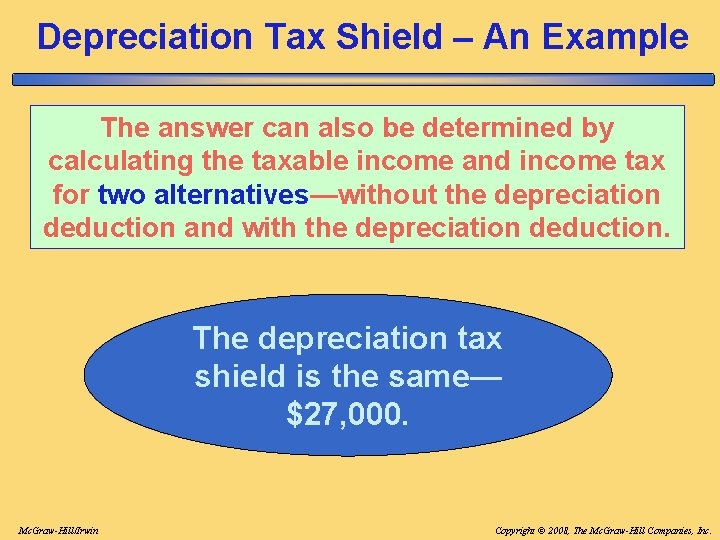
Depreciation Tax Shield – An Example The answer can also be determined by calculating the taxable income and income tax for two alternatives—without the depreciation deduction and with the depreciation deduction. The depreciation tax shield is the same— $27, 000. Mc. Graw-Hill/Irwin Copyright © 2008, The Mc. Graw-Hill Companies, Inc.

Holland Company – An Example Holland Company owns the mineral rights to land that has a deposit of ore. The company is deciding whether to purchase equipment and open a mine on the property. The mine would be depleted and closed in 10 years and the equipment would be sold for its salvage value. More information is provided on the next slide. Mc. Graw-Hill/Irwin Copyright © 2008, The Mc. Graw-Hill Companies, Inc.

Holland Company – An Example Should Holland open a mine on the property? Mc. Graw-Hill/Irwin Copyright © 2008, The Mc. Graw-Hill Companies, Inc.
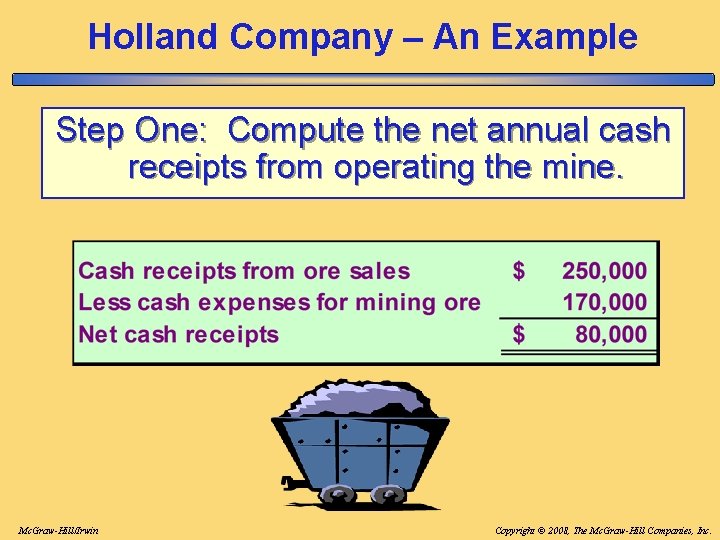
Holland Company – An Example Step One: Compute the net annual cash receipts from operating the mine. Mc. Graw-Hill/Irwin Copyright © 2008, The Mc. Graw-Hill Companies, Inc.
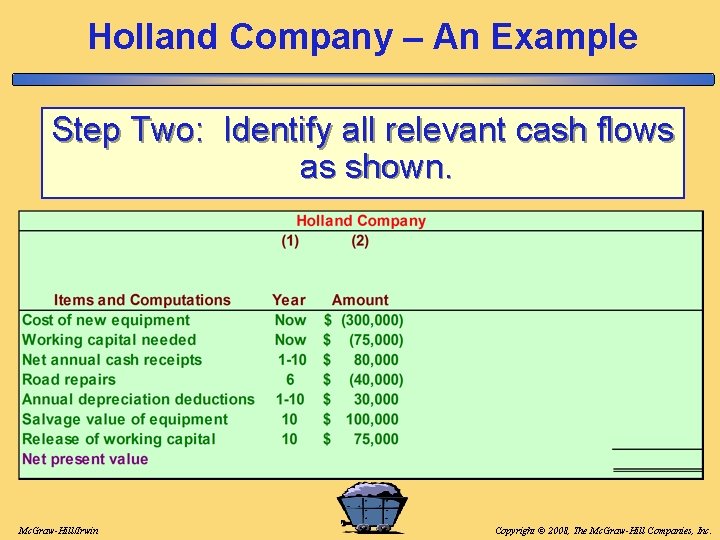
Holland Company – An Example Step Two: Identify all relevant cash flows as shown. Mc. Graw-Hill/Irwin Copyright © 2008, The Mc. Graw-Hill Companies, Inc.
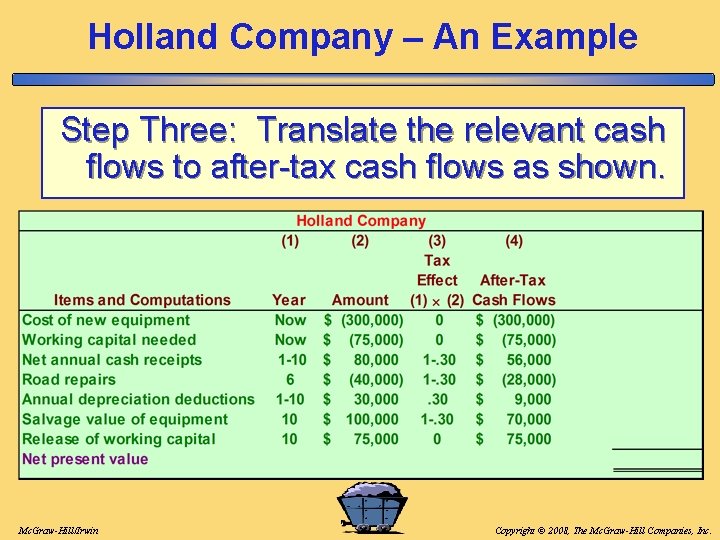
Holland Company – An Example Step Three: Translate the relevant cash flows to after-tax cash flows as shown. Mc. Graw-Hill/Irwin Copyright © 2008, The Mc. Graw-Hill Companies, Inc.
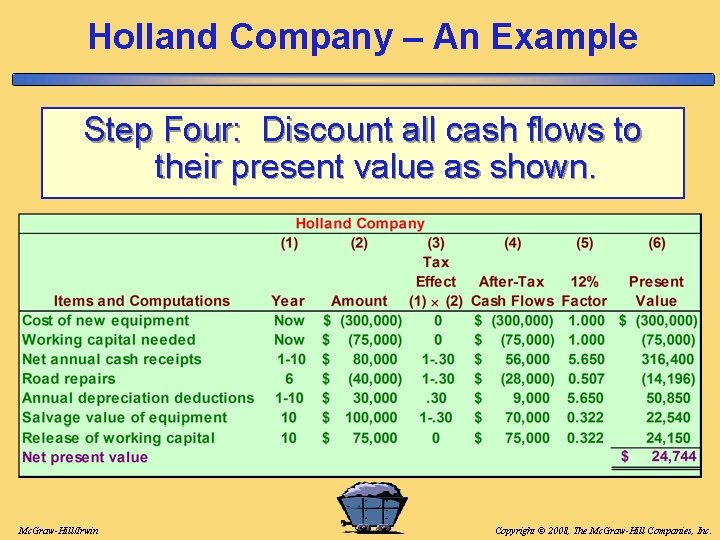
Holland Company – An Example Step Four: Discount all cash flows to their present value as shown. Mc. Graw-Hill/Irwin Copyright © 2008, The Mc. Graw-Hill Companies, Inc.
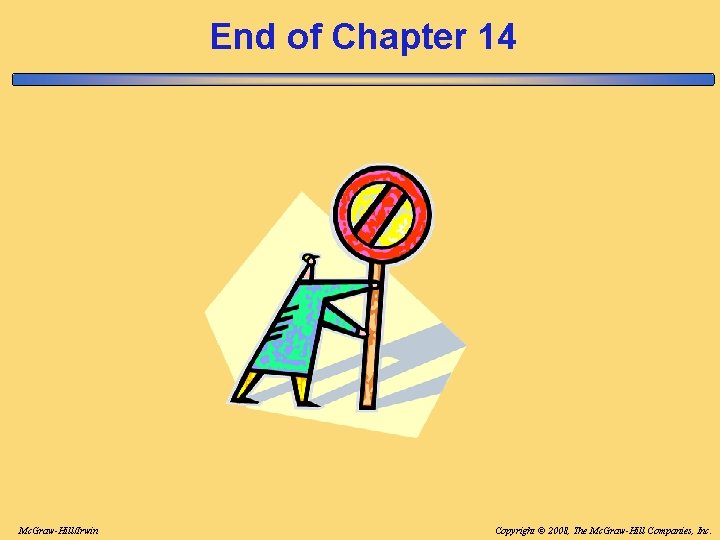
End of Chapter 14 Mc. Graw-Hill/Irwin Copyright © 2008, The Mc. Graw-Hill Companies, Inc.
- Slides: 120